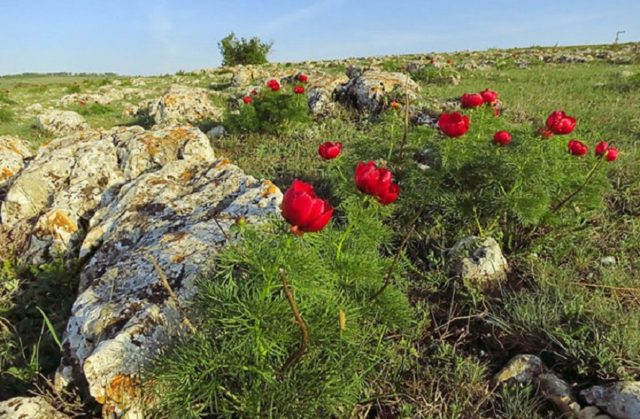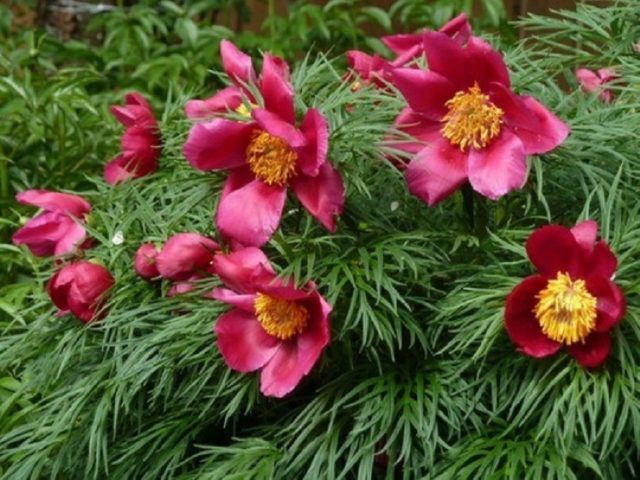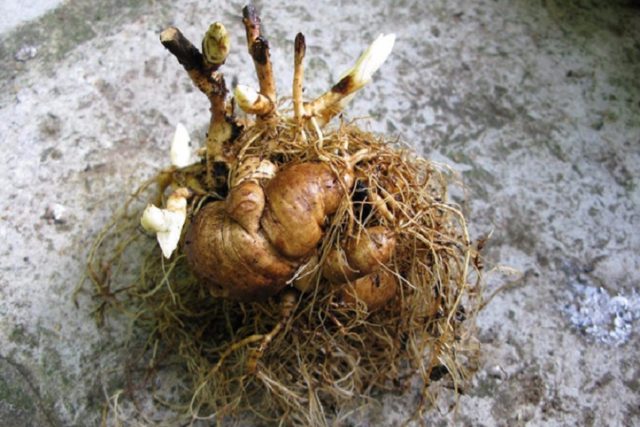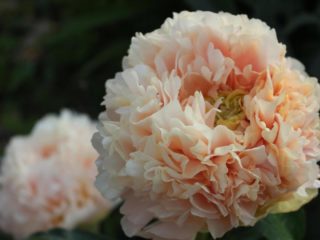Content
- 1 Full description of thin-leaved peony
- 2 Why is the thin-leaved peony listed in the Red Book?
- 3 Hybrids and varieties of thin-leaved peonies
- 4 Methods for propagating thin-leaved peony
- 5 Narrow-leaved peony in landscape design
- 6 Rules for planting thin-leaved peony
- 7 Care and cultivation of thin-leaved peonies
- 8 Pests and diseases
- 9 Medicinal properties of narrow-leaved peony
- 10 Conclusion
Thin-leaved peony is an amazingly beautiful perennial. It attracts attention with its bright red flowers and decorative leaves. The plant is also known to gardeners under other names - narrow-leaved peony or crowberry. In England he has another one - the fern peony, which the culture received for its spectacular dissected leaves. Belongs to herbaceous perennials of the Peony family. In Latin it is designated as Paeonia tenuifolia.
Full description of thin-leaved peony
Interesting fact - the narrow-leaved flower was very popular in the 70s and 80s of the last century. Then it was eclipsed by new varieties, and now the attention of admirers of the classics is again returning to the thin-leaved peony. Thanks to the original appearance of the Voronets and its characteristics, designers are again including the thin-leaved culture in projects for decorating areas.
Basic plant parameters:
- A herbaceous thin-leaved shrub 40-60 cm high. It reaches this size during the summer, then the above-ground part dies off by the end of August. You can safely classify it as a primrose, because the first sprouts of the angustifolia peony make their way through the snow. Perennial, grows in one place for up to 15 years. The shape of the bush is spherical and compact. With age, the Voronets become more magnificent and decorative.
- The rhizomes are not long, medium in size with thickened edges. The root system of the crowberry resembles potato tubers - oblong cones on short stalks.
- The stem is single-flowered, simple, glabrous. Height from 10 cm to 50 cm. Sometimes two-flowered stems are found.
- The leaves are the pride of the peony. They are amazingly beautiful in shape. Needle-shaped, openwork, dissected, similar to thin threads. The color is rich, bright green. There are a lot of leaves on the bush. They create such an attractive green ball that the flowers against their background become bright drops. And the leaves resemble a delicate edge.
Among the characteristics of the species, it is worth noting the unpretentiousness of the angustifolia peony and good frost resistance.
The photo below shows an amazing Voronets peony:

To grow a luxurious bush, you must adhere to the rules of agricultural technology
Where does thin-leaved peony grow?
In the wild, the species is found on the Balkan Peninsula, Crimea, the Caucasus, and southeastern Europe. Voronets prefers the steppe, the space between bushes and on steppe slopes. On the territory of Russia, thin-leaved peony can be found in the southern regions, Tambov, Belgorod, Voronezh regions. Most often it grows in forest-steppe or forests.
How narrow-leaved peony blooms
The flowers of the thin-leaved plant are large and bright red.There are dark purple or pinkish ones. The diameter of the flower is about 8-10 cm, consists of 5-8 petals. The aroma is delicate and pleasant. The flowers bloom at the same time, so the narrow-leaved crow looks like one huge bouquet. Voronets flowering begins in May and lasts up to 10 days. Among the varieties of narrow-leaved peony, there are double varieties that bloom for a longer period - about 14 days.
The flowering feature of the narrow-leaved peony is the ability to open its petals in the morning and close in the evening.
Why is the thin-leaved peony listed in the Red Book?
There are several reasons why the perennial has become a rare and protected plant in many countries. The angustifolia peony is listed in the Red Book, and its populations are under close attention of scientists. The reasons for the disappearance of a beautiful flower are:
- Healing properties of peony angustifolia. Previously, it was widespread throughout the country. However, the constant destruction of plantings for the sake of obtaining medicines led to the fact that the fine-leaved peony was included in the Red Book of Russia.
- Plowing the steppe or virgin lands, expanding areas for grazing. Another factor is the increase in haymaking areas.
- Many lovers of the narrow-leaved flower dug it up in the wild and brought it to their plots for planting. They were also collected for arranging bouquets, without giving the plant time for the seeds to ripen.
- Natural disasters - fires.
Currently, connoisseurs of narrow-leaved peony are trying to revive plantings.
Hybrids and varieties of thin-leaved peonies
The popularity of this amazing flower, its beauty and unpretentiousness attracted the attention of breeders. They have developed a number of fine-leaved hybrids, which are especially valued by peony lovers:
- Variety Rubra Plena. The bush is very compact, the height of an adult thin-leaved peony is no more than 50 cm. The flowers are scarlet, densely double, very bright. The diameter of each is about 10 cm; the thin-leaved variety blooms in May. Flowering is short-lived, only 5-7 days. But, it remains decorative until August, as long as the openwork foliage remains.
Despite the short flowering period, it is worth paying attention to this variety when drawing up the design of the site
- Hybrid Tiny Tim. The narrow-leaved peony is a completely different species, bred by US scientists. The petals of the flower are carved, deep red, the stamens are bright yellow, about 8 cm in diameter. The contrast of colors gives the plant an amazing decorative effect. It tolerates rocky soil well, so it is often used in the design of rock gardens.
Tinny Tim benefits from the contrast of color with the stones and fill
- Peony Early Scout. The height of the bush is no more than 50 cm, the flowers are large, bright red, simple. The diameter of one reaches 12 cm. The lanceolate thin leaves are dark green. The lush narrow-leaved perennial looks large due to the even shape of the bush. Frost-resistant variety, winters without shelter even in the middle zone. The thin-leaved shrub blooms at the end of May. Received first place in 2002 at a plant exhibition in the USA.
Early Scout will provide decorative flower beds all season until the beginning of autumn
- Eaglet. The variety was bred by scientists during the Soviet era. It is distinguished by a beautiful lush bush shape. The thin-leaved variety has slightly deviated stems and shiny green leaves. The size of an adult bush is about 60 cm. The flowers are simple red, up to 10 cm in diameter.
When planted in the sun, the color of the flower brightens and becomes carmine.
- Merry Meishein. Hybrid thin-leaved variety with large flowers. The hue is bright ruby, diameter up to 15 cm.The height of an adult bush is 60 cm, the stems are erect.
The early flowering variety can be mixed in flower beds with other annuals
There are many other simple and double varieties of thin-leaved peony that are in demand by gardeners. For example, Memorial Tem, Baby, Little Rhyme, Chocolate Soldier, Big Ban, Rose Gorland, Toy Dilight, Leddy, Smouthii, Herald.
Methods for propagating thin-leaved peony
Gardeners can grow this valuable crop on their own. There are only two optimal ways:
- dividing the bush;
- seeds.
Both are productive, but it is important to correctly determine the time for the procedure and the place for planting the peony. Each option has its own subtleties, they also need to be taken into account:
- Dividing the bush. A method with minimal effort and time for the gardener. Performed in the spring. Delenka is the name given to the adventitious roots of a thin-leaved perennial over 5 years old. To transplant a Voronets, 2 adventitious roots with 3-4 developed buds are enough. The size of the roots is 1.5 cm thick, 6-7 cm long. You will first need to dig planting holes for new narrow-leaved plants at a distance of 60 cm from each other. Lay a layer of organic fertilizer and mix it with the soil. Carefully remove the thin-leaved bush from the soil, using your hands or pruning shears to separate the parts for replanting. This option has one more advantage - it allows you to rejuvenate the old bush. The buds must be left 5 cm above the soil surface.
The cuttings for planting must be healthy and strong
- Sowing seeds. This method is used less frequently. The germination rate of planting material is not very high, even when purchased in a store. The advantage of this method is a large number of new Voronets seedlings compared to dividing the bush.A full-fledged narrow-leaved peony bush will be obtained in 4-5 years, seedlings will appear in 2 years. Seeds should be collected at an unripe stage, when the capsule is still closed. In this case, germination will be better. Immediately put them in the refrigerator until planting. Sowing time is autumn (October-November) or winter. In winter it is more difficult and longer, patience is required. But the seedlings turn out stronger and healthier. The collected seeds of a thin-leaved plant can be sown in the garden bed right away. You just need to first dig up and fertilize the soil. Shoots rarely appear the following spring, usually a year later.
To collect seeds, do not wait until the boxes open.
Another option is growing seedlings. It will take time to plant it. The collected seeds should be sown in clean sand. Take a flat container. Maintain the temperature during the day + 30 °C, at night + 15 °C. Moisten the soil regularly. When the first roots appear, transplant the peony seedlings into a box and reduce the temperature to + 10 °C. When the first leaves appear, move them to a warm place again. Voronets seedlings can be planted in the second ten days of August.
Narrow-leaved peony in landscape design
The emergence of a large number of garden forms allowed gardeners to use the thin-leaved species when creating compositions. According to the recommendations of experts, the species goes well with perennial flax, cereals, eremurus, broom bushes, and jasmine. Ideal for alpine slides. It is also practiced to simultaneously plant varieties of narrow-leaved peonies with different flowering periods or in combination with milky-flowering forms. Bushes of narrow-leaved crowberry peony are used to frame garden paths and mix them in ridges or borders. The flowers are ideal for cutting and bouquets.

The combination of red and green allows you to plant Voronets even as a tapeworm
Rules for planting thin-leaved peony
Voronets seedlings can be purchased at a garden center or grown from seeds. Then they need to be planted correctly. You can also buy cuttings of angustifolia peony in stores. The planting material must be inspected to ensure that it is not damaged. The process of planting a peony is simple, but it requires following all the steps:
- Choosing a location. It is necessary to take into account the short duration of flowering of the crop. Peony thin-leaved crow prefers partial shade or diffused light. He needs protection from winds and drafts, for example, a corner between buildings. A low-lying place is suitable, as the narrow-leaved peony loves moisture.
- Soil preparation. The thin-leaved plant is undemanding in terms of soil composition. But, when planted in nutritious loam, the crowberry blooms longer and brighter. The acid reaction indicator must be neutral or slightly alkaline. The bed needs to be dug up, weeded and leveled.
- In August or early September, dig planting holes for the crow. Depth 70 cm, diameter 60 cm. Lay a drainage layer of gravel or small stones 15 cm thick.
- Pour a fertile layer 20 cm thick. Ingredients: humus (10 kg), wood ash (0.5 cup), potassium sulfate (50 g), superphosphate (100 g). Sprinkle with garden soil.
- Bury the angustifolia peony to a distance of 10 cm, sprinkle with soil, water, and mulch with humus.

If planting measures are carried out accurately, seedlings will appear on time
Although the thin-leaved peony is a steppe plant, it can easily take root in the garden.
Care and cultivation of thin-leaved peonies
The crop is considered unpretentious among gardeners, but violations of agricultural practices can lead to problems.
Key activities that should not be neglected:
- Watering. This is the most regular procedure that the moisture-loving narrow-leaved peony needs. In dry summers it needs to be watered 3 times a week. The reference point is the top layer of soil. In order not to lead to stagnation of moisture, water the thin-leaved peony only when the top layer dries.
- Loosening and mulching. Peony needs light soil saturated with air. Loosening is best done after moistening, very carefully and no deeper than 10 cm. Mulching reduces the need for thin-leaved plants to water and prevents the growth of weeds.
- Feeding. If fertilizers were applied when laying the planting hole, then the peony does not need to be fed for the first 2 years. In the spring of the 3rd year, you will need to add urea and ammonium nitrate (50 g each). In autumn - a mineral complex with phosphorus and potassium components (according to instructions).Important! An overdose of nitrogen fertilizers will lead to a decrease in the number of buds.
- Transfer - another point for caring for narrow-leaved peony. The procedure for rejuvenating the bush should be done in the fall. The plant must be over 5 years old.
In addition to the above measures, it is important to monitor the possible appearance of pests or diseases.
Pests and diseases
Peony angustifolia can be affected by fungal infections. The main reason is overflow. Also, at the beginning of the growing season, the plant is threatened by aphids, ants and caterpillars. Preventive treatments with folk compositions or solutions of insecticides are necessary. The addition of dolomite flour or ash and copper-containing compounds helps a lot.

It is important to promptly treat the plant against pest attacks.
Medicinal properties of narrow-leaved peony
The healing characteristics of Voronets were the reason for its rapid disappearance.Although the plant is a poisonous species, its benefits to the body are very great.
It contains vitamin C, tannins, and healthy oils. For tinctures and lotions, leaves, buds and roots of a thin-leaved flower are used. The main therapeutic effects of peony are antispasmodic and analgesic. It is used in the manufacture of drugs for the treatment of:
- colds;
- anemia;
- epilepsy;
- problems of the cardiopulmonary system;
- disorders of the kidneys and lungs.
However, self-treatment is not encouraged. You can only use pharmaceutical drugs and as prescribed by a doctor.

Steppe Voronets has healing qualities
Conclusion
Thin-leaved peony has a lot of positive qualities. Luxurious decorativeness will be a gardener’s reward for patience, and unpretentiousness will help to grow a flower in any conditions.















